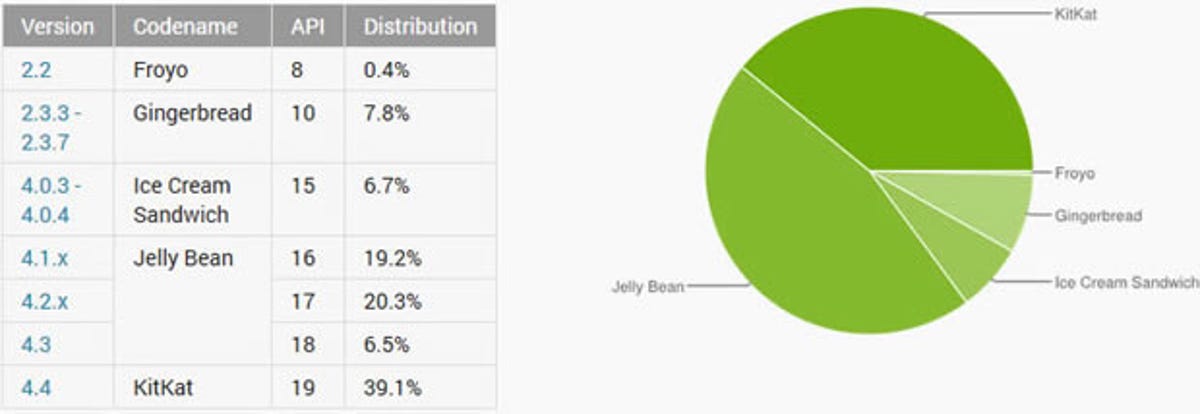
Android phone makers and carriers are filling up more devices with KitKat. Lollipop? Not so much.
In its latest Android Developers Dashboard posted earlier this week, Google revealed a 39.1 percent market share for Android 4.4 KitKat. Specifically, that percentage reflects the Android devices that visited the Google Play store during the seven days ending January 5.
Launched in October 2013, KitKat has been climbing the charts lately. The 39.1 percent share showed a steady rise from 33.9 percent a month ago, 30.2 percent the prior month and 25 percent in early September.
That’s good news for people craving KitKat. But what about Android users who want a taste of Lollipop, the latest version of Google’s mobile OS? Google has promoted Lollipop with a brand new design concept known as Material that offers animations and other visual effects. But where is it?
Lollipop, aka Android 5.0, doesn’t even appear on the developer dashboard. The page specifically says that “any versions with less than 0.1 percent distribution are not shown,” which means that Lollipop’s share is below that. In contrast, KitKat snared a 1.1 percent share during its first month, according to ZDNet. Lollipop was released on November 3, so it’s been in the wind for a little more than two months. That should have given it enough time to score more than a 0.1 percent share by this point. So what’s been happening?
Some device makers have already rolled out Android 5.0. LG and Motorola have been spreading it to certain of their key devices. Samsung has begun pushing it out in certain regions but not in the US yet. Sony has promised to kick off Lollipop to Xperia devices starting early 2015.
Google had started deploying the latest OS to some of its Nexus devices in November. But the rollout doesn’t seem to be hitting enough people at this point. For example, I have a Nexus 7 2013 tablet, and I’m still running KitKat 4.4.4. Google has also been forced to resolve some technical issues in Android 5.0 running on Nexus devices, prompting it to release Android 5.0.1 and Android 5.0.2.
But perhaps the biggest problem rests with the whole Android OS distribution process.
Before Google’s newest version can actually reach users, the mobile device makers must test and often customize it. Then the OS moves up the chain to the mobile carriers, who must also test as well as certify the OS and plan the deployment before they can actually push out the software to Android phones and tablets. And this process has to be done on a worldwide basis, country by country. Since the process can take so long, Google usually comes out with a brand new mobile OS before the current one has even reached a mass audience. That puts mobile device makers and carriers in a bind.


Released in 2012, Android Jelly Bean still has the biggest cut of the market with a 46 percent share, down from 48.7 percent last month. Ice Cream Sandwich and Gingerbread are still hanging in there with shares of 6.7 percent and 7.8 percent, respectively. In some cases, older Android devices simply aren’t capable of upgrading to newer versions, leaving them stuck with their current OS.
Google did not immediately respond to CNET’s request for comment.




